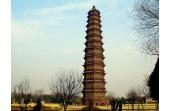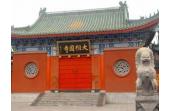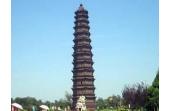Kaifeng
- Things to do
-
- Photo(30)
- Tips&article(70)
- Make it Happen
- Map
-
loading...
- Other Tours
Kaifeng is located in the east of Henan Province. It is one of the 24 famous historical and cultural cities in the list released by the State Council. Kaifeng covers an area of 6444 square kilometers (644400 hectares), with a population of 5 million. The district number here is 0378, the post code 475000. 72 kilometers from Zhengzhou which is the capital city of Henan Province, it is about a 45-minute drive from Kaifeng to Zhengzhou.
Kaifeng is the among the seven historical capitals of China. It is called “Metropolis of Seven Dynasties”. As early as in Northern Song Dynasty, Kaifeng has been the political, economic and cultural center of China. It was also one of the most developed and prosperous cities at that time, known as “International Metropolis”.
Each dynasty left rich historical and cultural heritage. For example, there are a variety of architectural styles in the ancient buildings in Kaifeng, with characteristics of different period such as Song Dynasty, Yuan Dynasty, Ming Dynasty, Qing Dynasty and the early Republic of China. Apart from historical sites like Long Ting (Dragon Pavilion), Tie Ta (Iron Tower Park), Xiang Guo Si (Shokokuji), Song Du Yu Jie (Imperial Street of Song Dynasty) and Qing Ming Shang He Yuan (Millennium City Park or Qingming Riverside Landscape Garden) represent the old glory of Kaifeng, capital city of Northern Song Dynasty.
Kaifeng is also famous as “City of Calligraphy and Traditional Chinese Painting” and “City of Traditional Opera”. Four famous Calligraphy styles “Su” (initiated by Su Shi), “Huang” (initiated by Huang Tingjian), “Mi” (initiated by Mi Fu) and “Cai” (initiated by Cai Xiang) originated here. Kaifeng is the birthplace of Xiang Fu Yune in Yu Ju (Henan Opera) and Henan Zhuizi. When traveling in Kaifeng, people can have a tour to the Painting and Calligraphy Institutes and some theaters. They may gain some serendipity.
History
In the history of China, Kaifeng was once called Daliang, Bianliang, Dongjing, Bianjing, etc. Kaifeng has a long history of more than 2700 years. Wei State in the period of Three Kingdom, the Later Liang Dynasty (907 A.D. – 923 A.D.), the Later Jin Dynasty (936 A.D. - 947 A.D.), the Later Han Dynasty (940 A.
D. – 950 A.D.) and the Later Zhou Dynasty (951 A.D. -960 A.D.) in the period of Five Dynasties, Northern Song Dynasty and seven dynasties in Jin all established their capital in Kaifeng. That is why Kaifeng is called “Capital City of Seven Dynasties”. Kaifeng, and Zhengzhou, Xi’an, Luoyang, Beijing, Nanjing, Hangzhou, Anyang are Eight Famous Ancient Capitals in China.
They are all well-known both home and broad.
Kaifeng got its name in the Spring and Autumn Period. Duke Zhuang of Zheng State chose to build a city here to store up grains. So Kaifeng got its first name “Qi Feng” due to the meaning of “Qi Tuo Feng Jiang” (meaning broaden the country). In 156 B.C., during the reign of Emperor Jing in Han Dynasty, in order to avoid using the name of Emperor Jing, whose name was Liu Qi, Qi Feng changed its name to Kaifeng.
Kifeng (also known as Dongjing historically) was the capital city of Song Dynasty for 168 year and 9 emperors set their capitals here. The circumference of Dongjing (ancient Kaifeng city) was over 30 kilometers (about 18.64 miles). It consisted of three layers of cities including outer city, inner city and imperial city, with three city moats.
The traffic and communication in Kaifeng was quite convenient, with both water transportation and land transportation. In terms of the layout of the city, Dongjing City no longer used the old Fang-and-li Style, on the contrary, it adopted a new style which opened the markets to the living quarters, which means it made the markets and living quarters into one.
This, to some extend, expanded the citizen stratum.
Kaifeng Qingming Cultural Festival
Qingming festival is known as Tomb-sweeping Day or Pure Brightness Day. It is one of Chinese traditional festivals as well as one of the most important holidays of sacrifice. The Han people and some minorities will hold sacrifice activities on that day. On May 29, 2006, the Qingming Festival was listed on the first batch of national intangible cultural heritage items. The Qingming Cultural festival is held from March 26 to April 11, 2011, on the Qingming River Park, Kaifeng City. (Location: No.5, Longting West Road, Kaifeng City, Henan Province. Visitors can take city bus No.1, 15 or 20 to get there.)
Activities
1. Qingming—Giving Willow
It is said that in China there are three ghosts' festivals which are Qingming Festival, Zhongyuan Festival (Hungary Ghost Festival) and Hanyi Festival. It is believed that on those three days, ghosts will haunt in the world. Willow is used to ward off death and devils, so people will wear willow to get rid of the ghosts.
Time: Start from 9:20 a.m. on April 5th.
Location: East gate of Qingming River Park
2. Kite Performance
Kite flying is one of the most favorite activities during the Qingming Festival. People will fly kites throughout the day. On the night, people will hang some colorful lanterns on the kite. In the past, people would some cut off the thread and let the kites flow away. It is said that this will remove ill fortunes and bring good lucks.
On both sides of the South and North Roads, there will be kite performances. Two huge swallow-shaped kites will hang on the two decorated archway of the east gate. Each of the kites which are 5 meters in height and width is made from steel and decorated with color paintings. During the performance, some people dressed in costumes of the Song Dynasty will perform kite flying.
Time: Start from 10:30 a.m. between April 4th and 5th.
Location: Outdoor Stage
3. Emperor Outing Performance
It is said that during the Northern Song Dynasty, emperor would take his officials to have an outing during the Qingming festival. Many people come out to the streets to greet. This performance tends to reappear what really happened then.
Time: From April 5th to 11th
Location: Outdoor Stage and the Qingming River Park
4. Folk Arts Performance
During the Northern Song Dynasty, there were many top folk arts. In the park, there will be some folk performances on show such as throwing axe, whip skill and Qigong skill etc.
Time: March 26th to April 11th
Location: Goulan Wasi
5. Hongqiao Reappearance
On the banks of Bian River, visitors can find the scene of crowded water transport, sheer volume of traffic and pedestrians and numerous merchants just like the picture of Riverside Scene of Pure Brightness, a famous ancient Chinese painting depicting the scene of Qingming Festival. The drum team will also give a performance on the bank of Bian River.
Time: Start from 10:30 a.m. between April 5th and 6th.
Location: Banks of Hongqiao, Qingming River Park
6. Women Polo Performance
In the park, there are women polo performances, which vividly show a picture of unique folk art during the Northern Song period.
Time: From March 26th to April 11th
Location: Polo court
7. Cuju performance
Cuju is kind of soccer and it means playing soccer. Cuju is another popular game that ancient people played during the Qingming festival. Cuju is made of leather and inserted with furs. It can be traced back the Spring and Autumn Period and has a history of around 2,300 years. Cuju was used to train soldiers and Cuju game was quite popular in the Northern Song Period.
Time: From March 26th to April 11th
Location: Cuju Playground
8. Taqing and Swing Performance
Taqing (spring outing) and swing are the customs of Qingming festival. In the park, boys and girls who dressed in Song pack are playing swings.
Time: from 10:30 to 11:30 a.m. between April 5th and 11th
Location: Fun Park
9. Cock Fighting Performance
Fighting cocks is another traditional activity during the Spring Festival. It used to be the most popular custom during the Song period especially in Kaifeng city. People find that cocks especially during the Qingming festival are mostly eager to fight. Therefore, the Qingming festival becomes a good time to watch cocks fighting.
Time: From March 26th to April 11th
Location: Stadium
10. Handicraft and Tourist Souvenirs Exhibition
The folk street of Qingming River Park and banks of Hongqiao mainly focus on Chinese traditional handicraft such as glass painting, paper-cut, branding picture and wood craving. Tourists can also experience the joy when they make those handicrafts by themselves.
Time: From March 26th to April 11th
Location: Qingming River Park and Hongqiao
11. Characteristic Food Exhibition
The Cold Food Festival is also known as Cooked Food Festival, Non-smoke Festival and Cold Festival. The Cold Food Festival is 105 days later than the winter solstice and only one or two days ahead of the Qingming Festival. As time goes by, people tend to celebrate the Cold Food Festival during the Qingming Festival. On the Cold Food Festival, people are not allowed to light fire and just can eat prepared cold food. During the festival, organizers have prepared some cold food for visitors such as boiled eggs, cold porridge, spring pancake, sticky rice and etc.
Time: Start from 11:30 a.m. from April 4th to 13th.
Location: Night Fair of Qingming River Park.
Tips & articles
|
|
|
forum discussion
|
|
|












